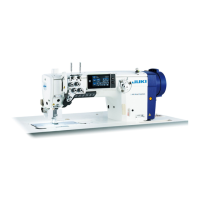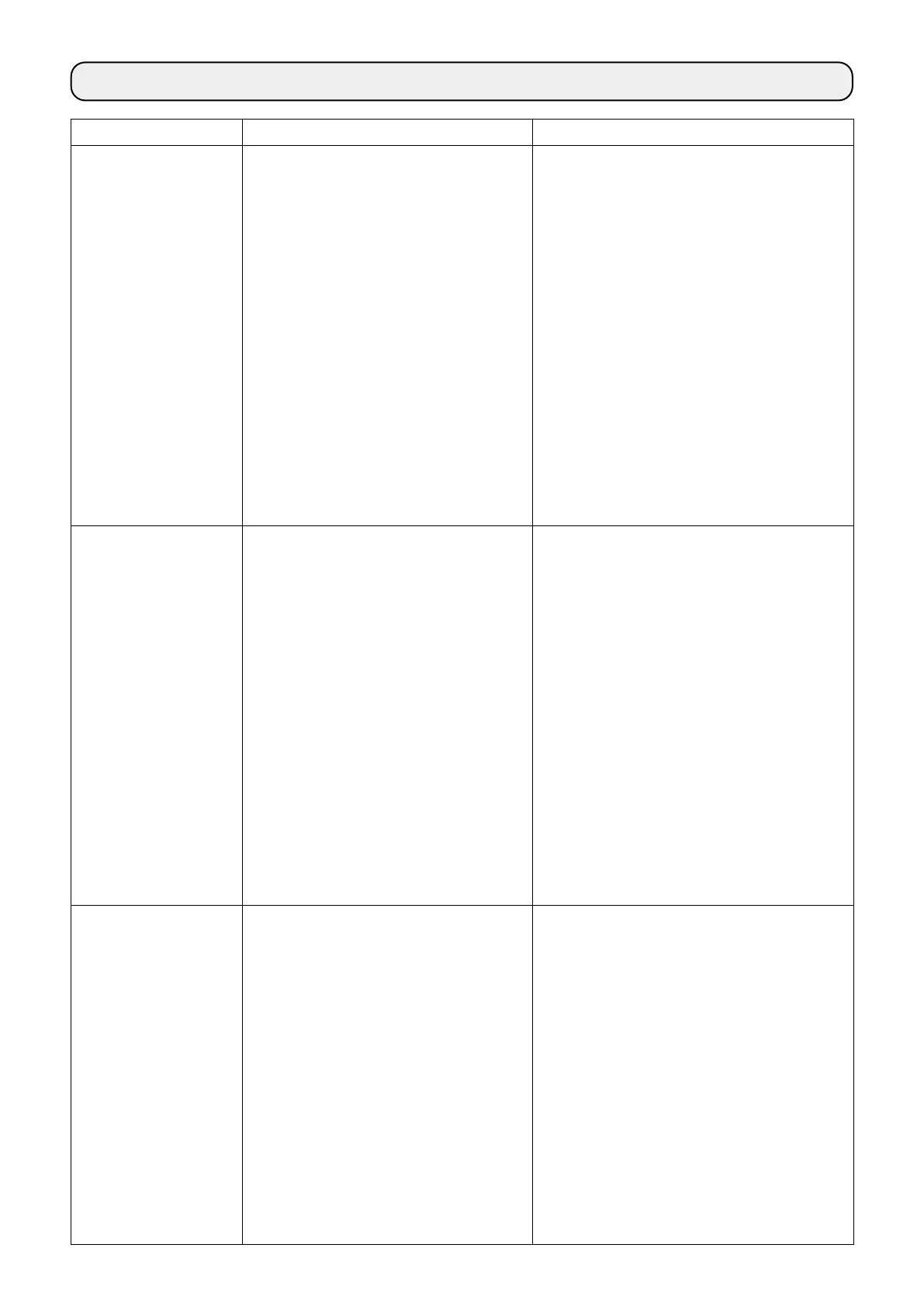– 164 –
11. TROUBLES IN SEWING AND CORRECTIVE MEASURES
Troubles Causes Corrective measures
1. Thread breakage
(Thread frays or is
worn out.)
(Needle thread trails
2 to 3 cm from the
wrong side of the
fabric.)
①
Thread path, needle point, hook blade
point or bobbin case resting groove on
the throat plate has sharp edges or burrs.
②
Needle thread tension is too high.
③
Bobbin case opening lever provides an
excessive clearance at the bobbin case.
④
Needle comes in contact with the blade
point of hook.
⑤
Amount of oil in the hook is too small.
⑥
Needle thread tension is too low.
⑦
Thread take-up spring works excessively
or the stroke of the spring is too small.
⑧
Timing between the needle and the hook
is excessively advanced or retarded.
○
Remove the sharp edges or burrs on the
blade point of hook using a ne emery paper.
Bu up the bobbin case resting groove on the
throat plate.
○
Decrease the needle thread tension.
○
Decrease the clearance provided between the
bobbin case opening lever and the bobbin.
Refer to
"8-4. Adjusting the bobbin case
opening lever" p.103
.
○
Refer to
"8-1. Needle-to-hook relation"
p.101
.
○
Adjust the amount of oil in the hook properly.
Refer to
"2-19. Lubrication" p.21
.
○
Increase the needle thread tension.
○
Decrease the tension of the spring and
increase the stroke of the spring.
○
Refer to
"8-1. Needle-to-hook relation"
p.101
.
2. Stitch skipping
(Two or three stitches
skip at the beginning
of sewing.)
①
Timing between the needle and the hook
is excessively advanced or retarded.
②
Pressure of the presser foot is too low.
③
The clearance provided between the top
end of the needle eyelet and the blade
point of hook is not correct.
④
Hook needle guard is not functional.
⑤
Improper type of needle is used.
⑥
The bobbin thread clamp pressure is low.
⑦
The stitch length at the beginning of
sewing is long.
○
Refer to
"8-1. Needle-to-hook relation"
p.101
.
○
Increase the presser foot pressure.
○
Refer to
"8-1. Needle-to-hook relation"
p.101
.
○
Refer to
"8-3. Adjusting the hook needle
guard" p.103
.
○
Replace the needle with one which is thicker
than the current needle by one count.
○
Increase the bobbin thread clamp pressure.
Refer to
"8-5. Adjusting the moving knife,
the counter knife and the bobbin thread
clamp" p.104
.
○
Enable the thread clamp function for the
beginning of sewing.
Refer to
"8-7. Adjusting the thread clamp
device" p.107
.
3. Loose stitches
(Revere feed
stitching)
①
Bobbin thread does not pass through the
tension spring of the inner hook.
②
The hook, feed dog and/or the thread
path in thread guide, etc. have worn out
or have aws.
③
Bobbin fails to move smoothly.
④
Bobbin case opening lever provides too
much clearance at the bobbin.
⑤
Bobbin thread tension is too low.
⑥
Bobbin has been wound too tightly.
⑦
The needle thread tension is low while
carrying out the reverse feed stitching.
⑧
The needle does not match the needle
hole in feed dog.
○
Thread the bobbin thread correctly.
○
Remove rough parts with a ne emery paper
or bu it up.
○
Replace the bobbin or hook with a new one.
○
Refer to
"8-4. Adjusting the bobbin case
opening lever" p.103
.
○
Increase the bobbin thread tension.
○
Decrease the tension applied to the bobbin
winder.
○
Advance the feed (horizontal feed) timing.
(Refer to the Engineer's Manual for the
adjustment procedure.)
○
Change the feed dog with an appropriate one.
(Refer to the Parts List.)

